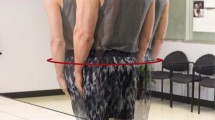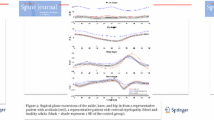Abstract
Study design
A nonrandomized, prospective, concurrent control cohort study.
Objective
To further develop cone of economy (CoE) measurements by identifying compensatory mechanisms at the extremes of the CoE and comparing balance control strategies in a group of adult degenerative scoliosis (ADS) patients with non-scoliotic controls.
Summary of background data
The CoE concept was first proposed by Dubousset and is frequently referred to when assessing balance in spinal deformity patients. Recently, a method that quantifies the CoE of individual patients through 3D video kinematic and electromyography data was developed. However, this method lacks measurements that describe the motor control strategies utilized by spinal disorder patients to maintain balance.
Patient sample
Twenty ADS patients and 15 non-scoliotic controls.
Methods
All test subjects were fitted with a full body marker set. Each subject performed a series of functional balance tests (Romberg’s with eyes opened) while being recorded in a human motion capture system. Three-dimensional CoE dimensions, range of sway (RoS), overall sway and lower extremity and trunk range of motion (RoM) were measured and analyzed.
Results
Patients with ADS demonstrated greater overall sway and RoS in the sagittal and coronal planes compared to controls. Moreover, ADS patients presented with more hip flexion and trunk flexion at maximal points of sway and more ankle, knee, hip and trunk RoM when swaying in comparison with controls.
Conclusions
ADS patients have larger CoE dimensions and increased sway when compared to non-scoliotic controls. ADS patients rely on a hip balance control “strategy” and lower extremity RoM to maintain balance, which differed from control subjects. Unlike prior attempts to define compensatory mechanisms in ADS patients, the described technique utilizes dynamic, three-dimensional measurements to define what is occurring within the CoE. By expanding on prior CoE measurements, we were able to define a unique dynamic balance control strategy for each patient.




Similar content being viewed by others
References
Dubousset J (1994) Three-dimensional analysis of the scoliotic deformity. The pediatric spine: principles and practice. Raven Press Ltd, New York
Haddas R, Lieberman I, Boah A, Arakal R, Belanger T, Ju KL (2019) Functional balance testing in cervical spondylotic myelopathy patients. Spine (Phila Pa 1976) 44:103–109. https://doi.org/10.1097/BRS.0000000000002768
Haddas R, Lieberman I (2019) The change in sway and neuromuscular activity in adult degenerative scoliosis patients pre and post surgery compared with controls. Spine (Phila Pa 1976) 44(15):E899–E907. https://doi.org/10.1097/BRS.0000000000003009
Haddas R, Lieberman IH (2018) A method to quantify the “cone of economy”. Eur Spine J 27:1178–1187. https://doi.org/10.1007/s00586-017-5321-2
Hasegawa K, Okamoto M, Hatsushikano S, Shimoda H, Ono M, Homma T, Watanabe K (2017) Standing sagittal alignment of the whole axial skeleton with reference to the gravity line in humans. J Anat 230:619–630. https://doi.org/10.1111/joa.12586
Barrey C, Roussouly P, Perrin G, Le Huec JC (2011) Sagittal balance disorders in severe degenerative spine. Can we identify the compensatory mechanisms? Eur Spine J 20(Suppl 5):626–633. https://doi.org/10.1007/s00586-011-1930-3
Diebo BG, Ferrero E, Lafage R, Challier V, Liabaud B, Liu S, Vital JM, Errico TJ, Schwab FJ, Lafage V (2015) Recruitment of compensatory mechanisms in sagittal spinal malalignment is age and regional deformity dependent: a full-standing axis analysis of key radiographical parameters. Spine 40:642–649
Diebo BG, Varghese JJ, Lafage R, Schwab FJ, Lafage V (2015) Sagittal alignment of the spine: what do you need to know? Clin Neurol Neurosurg 139:295–301
Yagi M, Ohne H, Kaneko S, Machida M, Yato Y, Asazuma T (2017) Does corrective spine surgery improve the standing balance in patients with adult spinal deformity? Spine J. https://doi.org/10.1016/j.spinee.2017.05.023
Barrey C, Roussouly P, Perrin G, Le Huec J-C (2011) Sagittal balance disorders in severe degenerative spine. Can we identify the compensatory mechanisms? Eur Spine J 20:626
Obeid I, Hauger O, Aunoble S, Bourghli A, Pellet N, Vital J-M (2011) Global analysis of sagittal spinal alignment in major deformities: correlation between lack of lumbar lordosis and flexion of the knee. Eur Spine J 20:681
Haddas R, Lieberman I, Boah A, Arakal R, Belanger T, Ju KL (2018) Functional balance testing in cervical spondylotic myelopathy patients. Spine (Phila Pa 1976). https://doi.org/10.1097/BRS.0000000000002768
Haddas R, Lieberman I, Block A, Derman P (2019) The effect of surgical decompression and fusion on functional balance in patients with degenerative lumbar spondylolisthesis. Spine. https://doi.org/10.1097/BRS.0000000000003436
Horak FB, Nashner LM (1986) Central programming of postural movements: adaptation to altered support-surface configurations. J Neurophysiol 55:1369–1381. https://doi.org/10.1152/jn.1986.55.6.1369
Bardy BG, Oullier O, Lagarde J, Stoffregen TA (2007) On perturbation and pattern coexistence in postural coordination dynamics. J Mot Behav 39:326–336. https://doi.org/10.3200/JMBR.39.4.326-336
Horak FB, Henry SM, Shumway-Cook A (1997) Postural perturbations: new insights for treatment of balance disorders. Phys Ther 77:517–533. https://doi.org/10.1093/ptj/77.5.517
Nashner LM, McCollum G (2010) The organization of human postural movements: a formal basis and experimental synthesis. Behavior Brain Sci 8:135. https://doi.org/10.1017/s0140525x00020008
Blenkinsop GM, Pain MTG, Hiley MJ (2017) Balance control strategies during perturbed and unperturbed balance in standing and handstand. R Soc Open Sci 4:161018. https://doi.org/10.1098/rsos.161018
O’Sullivan S, Schmitz T (2007) Physical rehabilitation. F.A. Davis Company, Philadelphia
Grivas TB, de Mauroy JC, Wood G, Rigo M, Hresko MT, Kotwicki T, Negrini S (2016) Brace Classification Study Group (BCSG): part one—definitions and atlas. Scoliosis Spinal Disord 11:43. https://doi.org/10.1186/s13013-016-0102-y
Savage JW, Patel AA (2014) Fixed sagittal plane imbalance. Glob Spine J 4:287–296. https://doi.org/10.1055/s-0034-1394126
Mok NW, Brauer SG, Hodges PW (2004) Hip strategy for balance control in quiet standing is reduced in people with low back pain. Spine 29:E107–E112
Runge CF, Shupert CL, Horak FB, Zajac FE (1999) Ankle and hip postural strategies defined by joint torques. Gait Posture 10:161–170. https://doi.org/10.1016/s0966-6362(99)00032-6
Kuo AD, Zajac FE (1993) A biomechanical analysis of muscle strength as a limiting factor in standing posture. J Biomech 26:137–150. https://doi.org/10.1016/0021-9290(93)90085-s
Kuo AD (1995) An optimal control model for analyzing human postural balance. IEEE Trans Biomed Eng 42:87–101. https://doi.org/10.1109/10.362914
Gauchard GC, Vancon G, Meyer P, Mainard D, Perrin PP (2010) On the role of knee joint in balance control and postural strategies: effects of total knee replacement in elderly subjects with knee osteoarthritis. Gait Posture 32:155–160. https://doi.org/10.1016/j.gaitpost.2010.04.002
Shiba Y, Taneichi H, Inami S, Moridaira H, Takeuchi D, Nohara Y (2016) Dynamic global sagittal alignment evaluated by three-dimensional gait analysis in patients with degenerative lumbar kyphoscoliosis. Eur Spine J 25:2572–2579
Author information
Authors and Affiliations
Corresponding author
Ethics declarations
Conflict of interest
The authors states that there is no conflict of interest.
IRB approval
The study was approved by the Western Institutional Review Board (IRB#: 20151780).
Additional information
Publisher's Note
Springer Nature remains neutral with regard to jurisdictional claims in published maps and institutional affiliations.
Rights and permissions
About this article
Cite this article
Haddas, R., Satin, A. & Lieberman, I. What is actually happening inside the “cone of economy”: compensatory mechanisms during a dynamic balance test. Eur Spine J 29, 2319–2328 (2020). https://doi.org/10.1007/s00586-020-06411-w
Received:
Revised:
Accepted:
Published:
Issue Date:
DOI: https://doi.org/10.1007/s00586-020-06411-w




